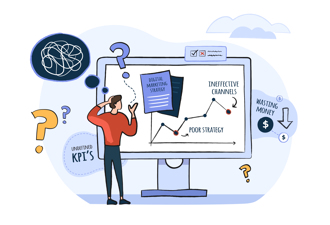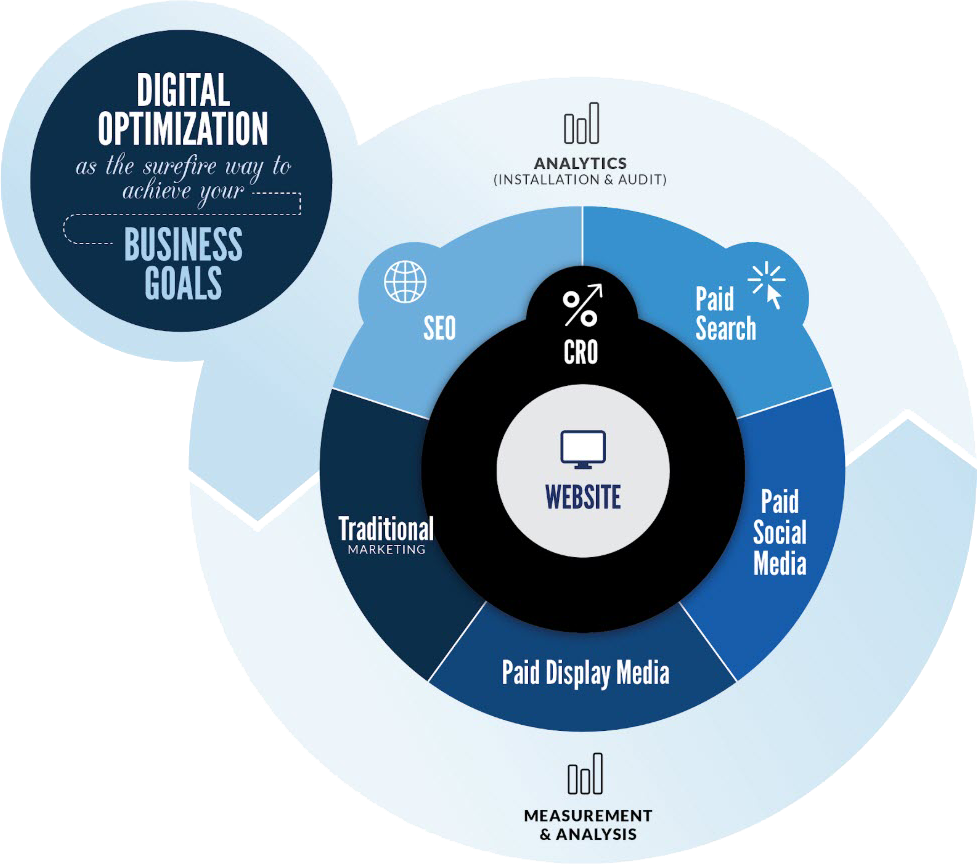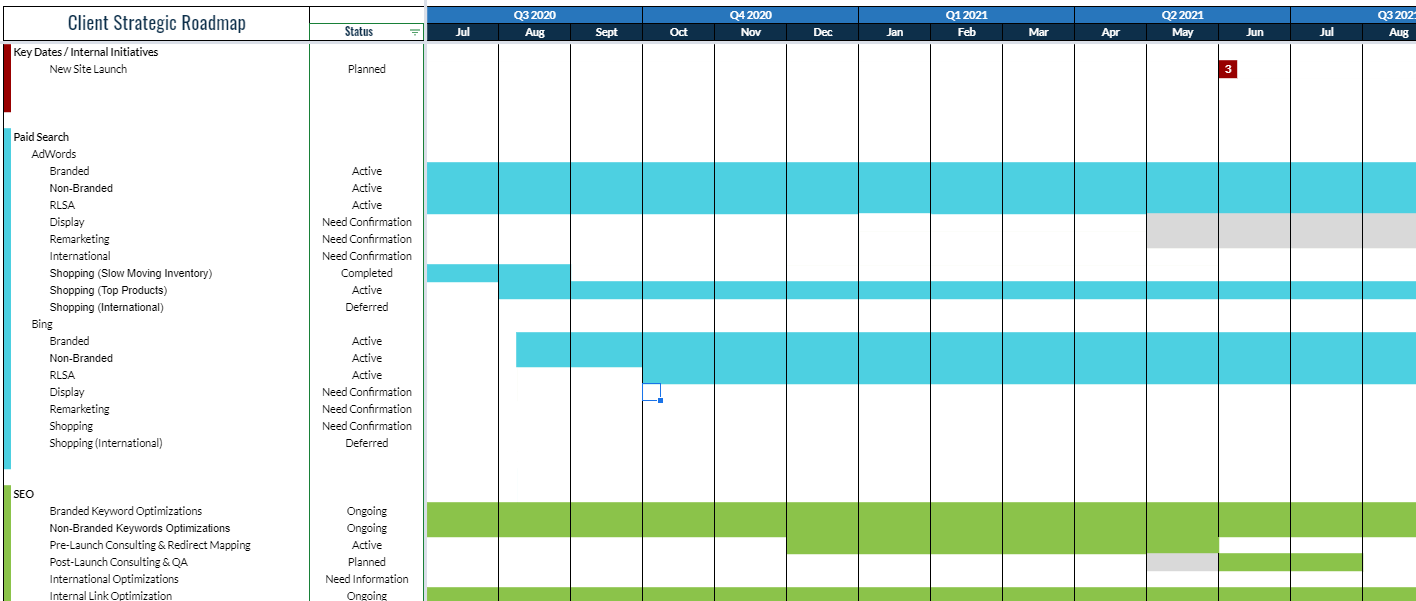
It’s the start of a new year, and many teams are evaluating their digital marketing strategy for 2021. Organizations of all sizes have put together plans for how to attract more customers. Many of those organizations will execute poorly vetted plans that will be hard to attribute success to and likely waste hard-earned dollars on ineffective channels. Worst of all, they will waste another incredible opportunity to crush their growth goals.
Over the years, I’ve worked with many organizations on their digital strategies. One of the challenges I’ve come across is the lack of standardization on what a digital strategy actually is. How do you create an effective digital marketing strategy when we don’t even know how to define it? All the channels, tactics, audiences, targets, and landing pages can create a confusing web of ideas reminiscent of a detective's corkboard on a forensic files documentary.
So how do we make sense of it all? While it’s easy to quickly get lost in the details of execution, it’s important to take a step back and understand the core elements of a digital strategy.
Table of Contents:
By taking a step back and looking at each of these elements individually, you can create more effective digital strategies that cater to your business goals and utilize marketing dollars and resources more effectively.
The Goal
The first item to address is your goal. What is your ultimate business goal? Don’t think about what you want your digital goal to be just yet. Too often we jump immediately to what we want to get out of our website or our paid search campaigns. All of the success of these channels should roll up to one primary business goal wherein KPIs by channel can be identified.
Too Loose Is Bad News
I can’t tell you how many times I’ve heard someone say “we want more traffic to our website” or “we want more awareness of our brand” when I ask what their goal is. Is that really your goal? If we get 1,000,000 more users to your site and not one of those users become a client, you’d pop champagne? Likely not.
Having too loose of a goal will result in confusion on the effectiveness of your marketing channels and, ultimately lead to wasted dollars.
State the Obvious
Your strategy has to tie to your primary business goal. While it might sound like common sense, it is important to state your primary business goal to your digital marketing team. This will unlock the right questions and allow your team to think more clearly about how to affect results.
Typically, and likely more obviously, business goals relate to revenue. They are tied to the growth of the company. State your highest level business goal, then identify how specific marketing channels can impact that goal.
This will help you to think strategically about which channels will have the greatest impact on your goal and to identify how you will measure the effectiveness of those channels.
A Quick Anecdote
At Marcel, we want everyone on the team to realize their impact on the growth of the organization. Each team member has a responsibility to understand how their day-to-day efforts directly impact our overall success.
Is our web dev team responsible for driving new leads? No. But they are responsible for creating efficient processes and new, innovative products that will allow our team to be more productive and expand our offerings to new and existing clients. Which impacts our growth.
Is our analytics team responsible for closing deals? Not likely. But they are responsible for proactively addressing clients’ Google Analytics needs and identifying new channels and opportunities that could impact their growth. Does that impact our growth? You betcha.
It’s important to remember that while each individual channel of your digital strategy might not have the primary goal of producing new revenue for your organization, they should effectively impact the growth of your primary goal through targeted efforts and be able to prove value through accurate measurement.
The Strategy
Now that you’ve identified your primary business goal, it’s time to talk strategy. Strategy can be defined in many different ways, but ultimately you are looking for an all-encompassing sentence (or 2) that summarizes your plan to achieve your goal. It should be a strong and clear statement that gives direction anyone both inside or outside your organization can easily understand.
For example, a strategy for an eComm site for growth in revenue might be:
To increase website sales revenue for X and Y products by 15%, we will strategically target A and B buyer personas and utilize a multi-touch digital strategy that captures these users at all stages of their buying journey.
Here is another example of a firm that wants to increase sales:
To increase corporate sales by 25%, we will maximize all bottom-of-funnel channels while feeding the top of the funnel through targeted programmatic efforts.
Here is an example of a B2B organization focused on lead generation:
To increase new-to-file leads by 10%, we will utilize top-of-the-funnel awareness channels to target specifically identified personas, and consideration and conversion channels to drive those same users down the path to conversion.
And here is an example of a service line in a hospital:
To increase patient volumes for Women’s Health by 15%, we will focus on the patient’s path from research to preventative care to diagnosis, and customize channels, messaging, and targeting at all stages of the funnel that are both informative and supportive leading up to an appointment request.
The strategy is more than just the statement, but is your first step in identifying the plan you will take to reach your goal.
Collaborate Like You Mean It
A strong strategy is built on collaboration. You know your business better than anyone. You know which products are more profitable, which audiences are the most desirable, and of course, you know your own historic sales data (hopefully.) While your digital team likely brings years of experience to the table, they will be looking to you to validate the strategy and to confirm specific details.
Ask questions. Let them ask questions. Challenge assumptions. Dig into the data. The more both teams understand the goal and how it might be reached, the more effective the execution of the strategy becomes.
Don’t Be Afraid to Pivot
While you don’t want to change your strategy every month, don’t be afraid of making adjustments.
If life throws you a curveball and demand for a particular product tanks due to, I don’t know, a pandemic, adjust accordingly. It will not benefit you to force a strategy that simply cannot succeed due to factors outside of your control. Identify what you can control and adjust accordingly.
Your strategy is how you will define the channels and tactics needed to reach your goal. It should be adhered to daily, looked at monthly, and evaluated quarterly in a Quarterly Business Review (QBR).

The Channels
Now that you’ve defined your strategy, it’s time to figure out how to execute it. Your strategy will help you to determine the channels that best help you reach your goal. Below are examples of channels you might utilize to reach your goal:
- SEO
- Paid Search
- Social Media Advertising
- Display / Programmatic / Remarketing
- Marketing Automation
But how do you determine which one(s) to utilize? First, it’s important to discuss how viable each of these options are for your organization.
- What is your overall budget?
- Do you have an internal team or will you need to work with an agency?
- What will the agency charge?
- Will internal resources be needed on our end to create content or creative assets?
If you are going to invest in a comprehensive digital marketing strategy, it’s important to understand your strengths and limitations.
After you’ve answered these questions, you can determine next steps on choosing appropriate channels.
An Example
Take the strategy we outlined above:
To increase overall revenue by increasing sales for our top three grossing products and improving sales for X and Y products by Z%. We will do this by strategically targeting A and B buyer personas and utilizing a multi-touch digital strategy that captures these users at all stages of their buying journey.
The first step is to increase sales for top grossing products and improve sales for X and Y products.
To start, we would want to maximize exposure to “hand raisers” or people actively searching for these products. Our top priority would be to create a solid foundation for searchers already at the bottom of the funnel. We may find that there is a huge opportunity to increase our impression share in paid search to become more competitive and increase sales for people already actively searching for these products.
We would also want to look at how much revenue we are driving for these products through organic search and see if there is an opportunity to improve rankings for these product focus areas.
The second step is to strategically target specific buyer personas to drive new exposure for our products at every stage of the funnel.
The best way to target specific personas is through a mixture of contextual and audience targeting, both of which can be done utilizing channels such as Display/Programmatic and Paid Social.
Let’s say this product has a higher consideration than an impulse buy, we may want to couple this with Remarketing and Marketing Automation to keep your brand top of mind during the consideration and research process.
Finding Your Mix
The possibilities are truly endless on the depth of your strategy. The amount at which to engage in each of these channels will depend entirely on budget and the current landscape. If budget is a limiting factor, it will be important to work closely with your digital team to prioritize these channels and ensure that you are properly executing on one or two channels versus poorly executing on many channels.

There is no right answer on how to execute. You might find that your team excels at producing educational content and resources so SEO is a great fit for your resources. You might also find that executing a simple marketing automation campaign can help to improve repeat buyers and seasonal sales. You’ll have to come up with channels that fit your strategy and your resources and, of course, pivot as necessary to utilize your marketing budget efficiently and effectively.
The Tactics
Once you’ve identified your channels, you’ll want to determine which tactics within those channels to employ. This is typically handled by a digital team with extensive experience and expertise, allowing you access to the latest tactics, tools, and tips to get the most out of each channel.
Turning the Right Knobs
There are literally hundreds of tactics under each channel to help you execute on your strategy, so how do we know which ones to use? Typically, you’ll want to use as many tactics under each channel as your budget permits. Your digital team will want to employ as many tools in the toolkit to best help you reach your goal.
Below are a handful of examples of tactics for three different channels:
Paid Search
- Negative keyword lists
- Ad extensions
- Remarketing list for search ads
- Dynamic search ads
- Testing
SEO
- Focus area SEO content creation
- Local SEO
- Targeted linkbuilding
- Onsite technical SEO optimizations
- Schema mark-up
Display
- Audience targeting
- Contextual targeting
- Creative testing
- Negative placements
- Geo-fencing
I could take up pages listing out every tactic for every channel, but this gives you a sense of knobs that can be turned to optimize each channel and produce results.
Remember, tactics roll up to channels that roll up to your overall strategy. This, in turn, produces results that affect your primary business goal.
Utilize a Roadmap
It is important to have a well-vetted roadmap that shows how when these channels and tactics will be deployed. This is helpful not only from an execution perspective but also from an alignment perspective. Developing a comprehensive roadmap ensures your digital calendar and your marketing calendar remain tightly aligned.

Your roadmap should be a living breathing document that can be updated as necessary. If the team gets a little behind on providing assets or creating content, shift the timeline. Use this roadmap as a single source of truth for execution so both teams stay honest and your strategy continues moving forward.
The Measurement
Given our highest level goal and our defined strategy, how do we measure success? There are a few things to think about when measuring success and it’s important to define Key Performance Indicators (KPIs) that most closely align with your highest level goal. We would typically choose normalized KPIs that can be measured across all channels equally (like revenue from Google Analytics) with secondary KPIs that show growth in other areas.
For example, we might define the primary KPI for all channels as revenue in Google Analytics, but also utilize secondary KPIs to show positive results from specific channels.
A good example of a secondary KPI for SEO would be to look at organic traffic growth for a particular focus area on the website that we optimized with technical updates and content additions via SEO. This shows us that the optimizations made via SEO are improving overall organic traffic which, in turn, is producing additional revenue through the organic channel.
Don’t Forget About Attribution
One of the easiest mistakes to make in measurement is to look strictly at revenue or conversions by channel in Google Analytics.
Google Analytics has a default measurement model of attributing the conversion or revenue to the last non-direct click (direct meaning people who typed in your website directly or arrived via a browser bookmark.) This means that even if the users came to your site via 5 channels from initial search to purchase, Google Analytics will only give credit to the final non-direct channel.
That’s an easy way to overlook the contributions other channels may have made on the path to purchase, causing you and your team to make decisions that may end up costing you revenue and conversions down the road.
Take a look at additional reporting in Google Analytics to get a better sense of how your channels are contributing to success. These reports give you a better idea of how each channel contributes to leads and purchases:
Looking at the whole picture will help you to better understand holistic channel performance and to determine the appropriate media mix.
 The Insight
The Insight
Sure, it’s easy to look at pages of charts and graphs and tables and mistake quantity of data for quality of performance. But how do you know what’s really working for you? When looking at your data, it’s important to think about the “so what?” Think to yourself, “Why is this important and why should I care?” More importantly, “What decisions should I be making based on the information?”
While you may not be a data analytics expert, you have armed yourself with enough knowledge to ask the right questions. Don’t take vendor reports at face value. Challenge the results. Ask questions. The more you understand the data, the more you can make data-driven marketing decisions.
And if you still aren’t sure or need additional expertise, that’s ok. Find yourself a trusted analytics partner to help verify and digest your data. Work with them to ensure all of your channels and systems are reporting correctly and as holistically as possible. Work out a regular cadence for reporting and insights and convey that information organizationally so your team can get used to the process.
Garnering insights from your data is perhaps the most important step as it brings you full circle. These insights should inform everything from channels to strategy, and perhaps even your goals. You can now make reporting easier with Google Data Studio!
What Now?
Now that you know how to define a goal, identify a strategy, select effective channels, deploy appropriate tactics, and measure for effectiveness, where do you begin?
It all starts with collaborative, meaningful discussions. Perhaps you’re new to digital strategy, perhaps you’ve been doing it for a long time. Take a step back and start at the top. Ensure that you’ve truly defined your highest level goal and evaluate where you’re at to reaching that goal.
Ask yourself these questions:
- What could we be doing differently?
- Is our strategy aligned with our highest level goals, or is it too loose?
- Is our strategy rooted in data?
- Are we trying to do too much?
- Do we know what is working and not working for us?
Once you have answers to these questions, sit down and work your way through the steps. Don’t be afraid to start from the beginning. Oftentimes our habits get in the way of our growth. Don’t allow yourself to fall into habits. Strategize, pivot, adjust, and lean on data and expertise.
Best of luck with your planning!
Digital Strategy
About the author
Kyle Brigham
Kyle Brigham is the Chief Strategy Officer at Marcel Digital. He specializes in client services and project management, but also original Nintendo games and ping pong.